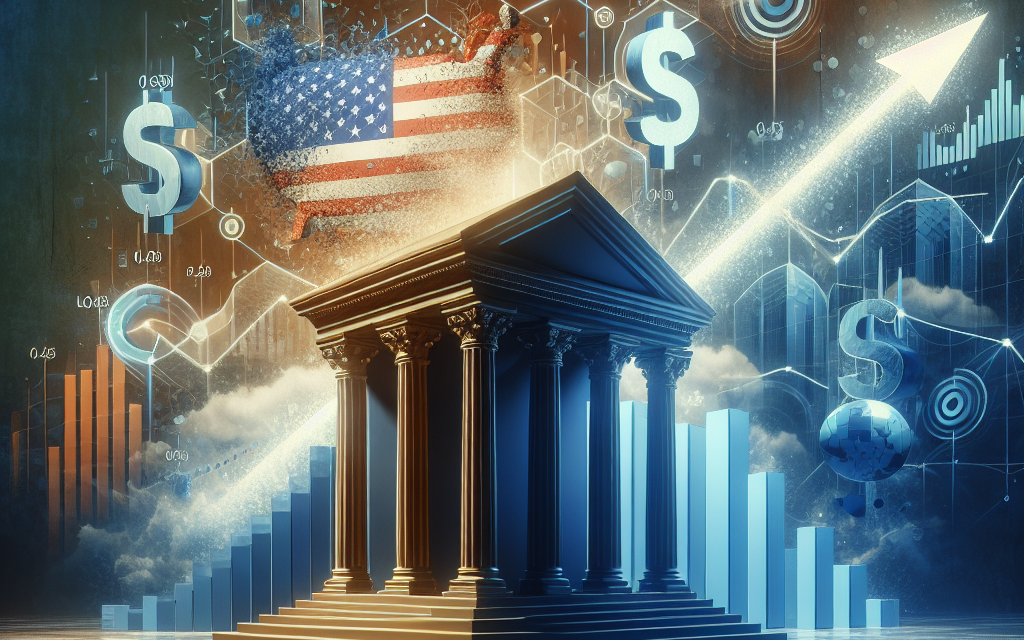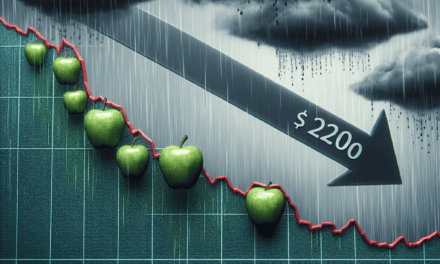“US Capital Flows Surge: A Testament to Economic Strength and Safe Asset Appeal.”
Introduction
The recent surge in capital flows into the United States has been attributed to the country’s robust economic performance and heightened demand for safe assets, as highlighted by the White House. This influx of investment reflects growing confidence in the U.S. economy, characterized by strong growth indicators, low unemployment rates, and resilient consumer spending. Additionally, global uncertainties and geopolitical tensions have driven investors to seek the stability of U.S. financial markets, further bolstering capital inflows. This trend underscores the U.S.’s position as a safe haven for investors, reinforcing its economic strength on the global stage.
Capital Flows Surge: Analyzing the Impact on the US Economy
In recent months, the United States has witnessed a significant surge in capital flows, a trend that has been attributed to the robust performance of the economy and an increasing demand for safe assets. According to a report from the White House, this influx of capital not only reflects investor confidence but also underscores the attractiveness of the U.S. market in a global context. As investors seek stability amid geopolitical uncertainties and fluctuating markets, the U.S. economy stands out as a beacon of resilience, drawing both domestic and international capital.
The implications of this surge in capital flows are multifaceted. First and foremost, increased investment in the U.S. economy can lead to enhanced economic growth. When capital is directed toward businesses, infrastructure, and innovation, it fosters an environment conducive to job creation and productivity improvements. This, in turn, can stimulate consumer spending, as a more robust job market typically leads to higher disposable incomes. Consequently, the cycle of economic growth is reinforced, creating a positive feedback loop that benefits various sectors of the economy.
Moreover, the influx of capital has significant implications for the financial markets. As more investors seek to allocate their resources in U.S. assets, there is a corresponding increase in demand for U.S. Treasury securities. This heightened demand can lead to lower yields on government bonds, which may influence borrowing costs across the economy. Lower interest rates can encourage businesses and consumers to take on loans for expansion and consumption, further fueling economic activity. Thus, the dynamics of capital flows not only impact the immediate financial landscape but also shape the broader economic environment.
In addition to these domestic benefits, the surge in capital flows also enhances the United States’ position in the global economy. As foreign investors flock to U.S. markets, it reinforces the dollar’s status as the world’s primary reserve currency. This status provides the U.S. with a unique advantage, allowing it to finance its deficits more easily and maintain lower borrowing costs. Furthermore, a strong dollar can attract even more foreign investment, creating a virtuous cycle that bolsters the economy.
However, it is essential to consider the potential challenges that may arise from this influx of capital. While increased investment can drive growth, it can also lead to asset bubbles if not managed prudently. Rapid inflows of capital can distort market valuations, leading to unsustainable price increases in certain sectors. Therefore, policymakers must remain vigilant and implement measures to ensure that the benefits of capital flows do not come at the expense of long-term economic stability.
In conclusion, the recent surge in capital flows into the United States is a testament to the strength of the economy and the demand for safe assets. This trend has the potential to drive economic growth, lower borrowing costs, and enhance the U.S.’s position in the global market. However, it is crucial for policymakers to navigate the complexities associated with these capital movements carefully. By fostering an environment that encourages sustainable investment while mitigating risks, the U.S. can harness the benefits of increased capital flows to support a thriving economy for years to come. As the global landscape continues to evolve, the ability of the U.S. to attract and manage capital will remain a critical factor in its economic success.
Safe Asset Demand: What It Means for Investors
The recent surge in capital flows into the United States has been attributed to a combination of a robust economy and an increasing demand for safe assets, as highlighted by the White House. This phenomenon has significant implications for investors, particularly in the context of global financial markets that are often characterized by volatility and uncertainty. As investors seek refuge from geopolitical tensions and economic instability, the U.S. economy stands out as a beacon of stability, attracting both domestic and international capital.
Safe assets, which typically include government bonds, high-quality corporate debt, and other low-risk financial instruments, are increasingly sought after in times of economic uncertainty. The U.S. Treasury securities, in particular, are viewed as one of the safest investments available, given the full faith and credit of the U.S. government. This perception of safety is bolstered by the country’s strong economic fundamentals, including low unemployment rates, steady GDP growth, and a resilient consumer base. Consequently, as global investors flock to these safe assets, they not only seek to preserve their capital but also to secure a reliable source of income.
Moreover, the demand for safe assets has been further intensified by the ongoing shifts in monetary policy across various countries. As central banks around the world grapple with inflationary pressures and the need to stabilize their economies, many have adopted more cautious stances. This has led to a divergence in interest rates, with the U.S. Federal Reserve maintaining a relatively higher rate environment compared to its counterparts. As a result, U.S. assets become more attractive, offering better yields in comparison to those available in other markets. This yield differential encourages foreign investment, thereby amplifying the inflow of capital into the U.S. economy.
For investors, this trend presents both opportunities and challenges. On one hand, the influx of capital can lead to increased liquidity in the markets, which may drive asset prices higher. This environment can be particularly beneficial for equity investors, as rising stock prices often correlate with a strong economic backdrop. Additionally, the demand for safe assets can provide a cushion during periods of market volatility, allowing investors to balance their portfolios with lower-risk investments.
On the other hand, the heightened demand for safe assets can also lead to lower yields, which may impact income-focused investors. As prices for U.S. Treasury securities rise due to increased demand, the yields on these bonds tend to fall, potentially reducing the income generated from fixed-income investments. This scenario compels investors to reassess their strategies, seeking alternative avenues for yield while maintaining a focus on capital preservation.
Furthermore, the dynamics of capital flows can influence currency valuations, particularly the strength of the U.S. dollar. As foreign investors purchase U.S. assets, they typically need to convert their local currencies into dollars, thereby increasing demand for the currency. A stronger dollar can have mixed effects on the economy, benefiting consumers through lower import prices while potentially challenging exporters who face higher costs in foreign markets.
In conclusion, the surge in capital flows into the United States, driven by robust economic performance and a heightened demand for safe assets, presents a complex landscape for investors. While opportunities abound in a liquid market with rising asset prices, the challenges of lower yields and currency fluctuations necessitate a careful and strategic approach to investment decisions. As the global economic environment continues to evolve, staying informed and adaptable will be crucial for navigating these changing dynamics.
The Role of the White House in Shaping Capital Flows
The White House plays a pivotal role in shaping capital flows within the United States, influencing both domestic and international perceptions of the U.S. economy. As the epicenter of federal policy-making, the White House’s decisions and communications can significantly impact investor confidence and capital allocation. In recent times, the surge in capital flows into the U.S. has been attributed to a combination of a robust economy and an increasing demand for safe assets, a trend that the White House has actively sought to promote through various economic policies.
One of the primary ways the White House influences capital flows is through fiscal and monetary policy. By implementing tax reforms, increasing government spending, or adjusting regulatory frameworks, the administration can create an environment that is conducive to investment. For instance, tax incentives for businesses can stimulate domestic investment, while infrastructure spending can enhance productivity and attract foreign capital. These policies not only bolster economic growth but also signal to investors that the U.S. remains a favorable destination for capital.
Moreover, the White House’s communication strategy plays a crucial role in shaping market expectations. Clear and consistent messaging regarding economic performance, job growth, and inflation can reassure investors about the stability and growth potential of the U.S. economy. In times of uncertainty, such as during global economic downturns or geopolitical tensions, the administration’s ability to convey confidence can mitigate fears and encourage capital inflows. This is particularly important in a global context where investors are constantly weighing risks and returns across different markets.
In addition to domestic policies, the White House also engages in international diplomacy, which can have a profound impact on capital flows. Trade agreements, for example, can open new markets for U.S. goods and services, thereby attracting foreign investment. Conversely, trade tensions can lead to capital flight as investors seek safer havens. The administration’s approach to international relations, therefore, directly influences how foreign investors perceive the U.S. market. A stable and cooperative foreign policy can enhance the attractiveness of U.S. assets, while a confrontational stance may deter investment.
Furthermore, the White House’s response to economic crises is critical in shaping capital flows. During periods of economic distress, swift and decisive action can restore confidence among investors. For instance, the implementation of stimulus packages or emergency measures can provide immediate support to the economy, thereby encouraging capital to flow back into the market. The administration’s ability to navigate economic challenges effectively can reinforce the perception of the U.S. as a safe haven for investment, particularly in times of global uncertainty.
As the demand for safe assets continues to rise, the White House’s role in maintaining the U.S. dollar’s status as the world’s primary reserve currency becomes increasingly important. Policies that promote fiscal responsibility and economic stability are essential in ensuring that the dollar remains a preferred choice for investors seeking security. This, in turn, reinforces the flow of capital into the U.S., as both domestic and foreign investors seek to capitalize on the perceived safety and reliability of U.S. assets.
In conclusion, the White House’s influence on capital flows is multifaceted, encompassing fiscal policy, communication strategies, international diplomacy, and crisis management. As the U.S. economy continues to demonstrate resilience, the administration’s efforts to foster a favorable investment climate will be crucial in sustaining the surge in capital flows. By effectively navigating these dynamics, the White House not only shapes the economic landscape but also reinforces the United States’ position as a global leader in attracting investment.
Economic Indicators Driving Capital Influx into the US
The recent surge in capital flows into the United States can be attributed to a combination of robust economic indicators and an increasing demand for safe assets. As the global economy experiences fluctuations and uncertainties, investors are increasingly seeking refuge in the stability offered by the U.S. market. This trend has been underscored by various economic metrics that highlight the resilience and growth potential of the American economy.
One of the primary indicators driving this influx is the consistent growth in the U.S. Gross Domestic Product (GDP). Recent reports have shown that the U.S. economy has been expanding at a rate that outpaces many of its global counterparts. This growth is not merely a short-term phenomenon; rather, it reflects a sustained recovery from the disruptions caused by the pandemic. As businesses reopen and consumer spending rebounds, the GDP figures have provided a strong signal to investors that the U.S. economy is on a solid footing. Consequently, this has led to increased confidence among both domestic and international investors, prompting them to allocate more capital to U.S. assets.
In addition to GDP growth, the labor market has shown remarkable resilience, further bolstering investor confidence. The unemployment rate has steadily declined, reaching levels that indicate a tight labor market. This improvement in employment figures not only enhances consumer confidence but also stimulates spending, which is a critical driver of economic growth. As more individuals find jobs and disposable incomes rise, the overall economic landscape becomes more attractive to investors. This positive feedback loop reinforces the notion that the U.S. economy is a safe and lucrative environment for capital investment.
Moreover, inflation rates have remained relatively stable, which is another crucial factor influencing capital flows. While inflation is a concern in many parts of the world, the U.S. has managed to maintain a balance that reassures investors. The Federal Reserve’s commitment to managing inflation through prudent monetary policy has played a significant role in this regard. By signaling its intent to keep inflation in check, the Fed has fostered an environment where investors feel secure in their investments, further driving capital into the U.S. market.
Another important aspect contributing to the surge in capital flows is the demand for safe-haven assets. In times of geopolitical uncertainty and economic volatility, investors often gravitate towards assets perceived as stable and secure. U.S. Treasury securities, for instance, have long been regarded as one of the safest investments available. The current global landscape, marked by tensions in various regions and economic instability in several countries, has heightened this demand. As a result, capital is flowing into U.S. Treasuries, reflecting a broader trend of seeking safety in uncertain times.
Furthermore, the technological advancements and innovations emerging from the U.S. economy have attracted significant foreign investment. The tech sector, in particular, has been a magnet for capital, as companies continue to push the boundaries of innovation. This influx of investment not only supports economic growth but also enhances the overall competitiveness of the U.S. economy on the global stage.
In conclusion, the surge in capital flows into the United States can be attributed to a confluence of robust economic indicators, a stable labor market, controlled inflation, and the demand for safe assets. As these factors continue to evolve, they will likely sustain the momentum of capital inflow, reinforcing the U.S. position as a leading destination for investment in an increasingly complex global economy.
Global Perspectives: How US Capital Flows Compare Internationally
In recent years, the dynamics of global capital flows have undergone significant transformations, with the United States emerging as a focal point for international investors. According to the White House, the surge in US capital flows can be attributed to a robust domestic economy and an increasing demand for safe assets. This phenomenon not only highlights the attractiveness of the US market but also invites a comparative analysis of how these capital flows stand in relation to other countries.
To begin with, the United States has long been viewed as a safe haven for investors, particularly during periods of economic uncertainty. The stability of its financial institutions, coupled with a transparent regulatory environment, has fostered confidence among both domestic and foreign investors. As a result, capital flows into the US have surged, reflecting a broader trend where investors seek refuge in assets perceived as low-risk. This trend is particularly pronounced when compared to emerging markets, where political instability and economic volatility often deter investment. In contrast, the US economy’s resilience, characterized by steady growth and low unemployment rates, has made it an attractive destination for capital.
Moreover, the demand for US Treasury securities has reached unprecedented levels, further underscoring the country’s position in the global financial landscape. Investors from around the world are increasingly purchasing these securities, viewing them as a reliable store of value. This influx of capital not only strengthens the US dollar but also enhances the country’s ability to finance its budget deficits and invest in infrastructure and social programs. In comparison, other developed economies, such as those in the Eurozone, have struggled with sluggish growth and low interest rates, which have diminished their appeal as investment destinations. Consequently, the US has gained a competitive edge, attracting capital that might otherwise have flowed to these regions.
Transitioning to the perspective of emerging markets, it is essential to recognize the challenges they face in attracting foreign investment. While some countries have made strides in improving their economic fundamentals, they often lack the institutional frameworks that provide the same level of security found in the US. As a result, capital flows to these markets tend to be more volatile and susceptible to external shocks. In contrast, the stability of the US economy acts as a magnet for capital, drawing investors who prioritize safety and predictability over potentially higher returns in riskier markets.
Furthermore, the global economic landscape is increasingly interconnected, and shifts in US capital flows can have ripple effects worldwide. For instance, as capital continues to pour into the US, other countries may experience capital outflows, leading to currency depreciation and increased borrowing costs. This scenario can create a challenging environment for nations that rely on foreign investment to fuel their growth. In this context, the US not only benefits from its own economic strength but also plays a pivotal role in shaping global capital flows.
In conclusion, the surge in US capital flows, driven by a robust economy and heightened demand for safe assets, positions the United States as a leader in the global financial arena. When compared to other countries, particularly emerging markets and developed economies facing their own challenges, the US stands out as a beacon of stability and opportunity. As investors continue to navigate the complexities of the global economy, the allure of US assets is likely to remain strong, further solidifying the country’s role in international capital markets.
Future Trends: Sustaining Capital Flows Amid Economic Changes
As the United States continues to experience a robust economic recovery, the surge in capital flows has become a focal point for policymakers and investors alike. The White House has highlighted this trend, attributing it to a combination of strong economic fundamentals and an increasing demand for safe assets. However, as the global economic landscape evolves, it is essential to consider how the U.S. can sustain these capital flows amid potential changes in both domestic and international conditions.
One of the primary drivers of capital inflows is the resilience of the U.S. economy, characterized by steady growth, low unemployment rates, and a stable inflation environment. These factors create an attractive investment climate, encouraging both domestic and foreign investors to allocate resources into U.S. markets. Furthermore, the U.S. dollar’s status as the world’s primary reserve currency enhances its appeal, as investors seek to mitigate risks associated with currency fluctuations. This dynamic not only bolsters capital flows but also reinforces the dollar’s dominance in global finance.
In addition to economic stability, the demand for safe assets plays a crucial role in sustaining capital flows. In times of uncertainty, investors often gravitate towards U.S. Treasury securities, which are perceived as low-risk investments. The ongoing geopolitical tensions and economic volatility in various regions have heightened this demand, leading to increased purchases of U.S. government bonds. As a result, the U.S. Treasury market has seen significant inflows, further solidifying the country’s position as a safe haven for capital.
However, while the current environment is favorable, it is important to recognize that economic conditions are subject to change. Factors such as shifts in monetary policy, inflationary pressures, and global economic disruptions could impact the attractiveness of U.S. assets. For instance, if the Federal Reserve were to adopt a more aggressive stance on interest rates to combat inflation, it could lead to increased borrowing costs and potentially dampen economic growth. Such a scenario might prompt investors to reassess their strategies, which could, in turn, affect capital flows.
Moreover, the rise of emerging markets presents both opportunities and challenges for the U.S. capital landscape. As countries like China and India continue to grow, they are becoming increasingly attractive destinations for investment. This shift could divert capital away from the U.S., particularly if these markets offer higher returns or more favorable regulatory environments. To counter this trend, the U.S. must remain vigilant in promoting policies that enhance its competitiveness, such as investing in infrastructure, fostering innovation, and ensuring a favorable business climate.
In light of these considerations, it is imperative for U.S. policymakers to adopt a proactive approach to sustain capital flows. This includes not only maintaining economic stability but also addressing potential risks that could undermine investor confidence. By fostering a transparent regulatory environment and encouraging foreign direct investment, the U.S. can enhance its appeal as a destination for capital.
In conclusion, while the current surge in capital flows reflects a robust U.S. economy and a strong demand for safe assets, the future will require careful navigation of evolving economic conditions. By prioritizing stability and competitiveness, the U.S. can position itself to sustain these capital flows, ensuring continued growth and resilience in an ever-changing global landscape.
Policy Implications of Increased Capital Flows in the US
The recent surge in capital flows into the United States, as highlighted by the White House, underscores the implications of a robust economy and the growing demand for safe assets. This influx of capital not only reflects investor confidence in the U.S. economic landscape but also raises important policy considerations that could shape the future trajectory of the nation’s financial and economic environment. As capital flows increase, policymakers must navigate the complexities associated with this phenomenon, ensuring that the benefits are maximized while potential risks are mitigated.
One of the primary implications of increased capital flows is the potential for enhanced economic growth. With more foreign investment entering the U.S. market, businesses can access additional resources for expansion, innovation, and job creation. This influx can stimulate various sectors, particularly those that are capital-intensive, such as technology and infrastructure. However, while the immediate effects may be positive, policymakers must remain vigilant about the long-term sustainability of this growth. It is essential to ensure that the economy does not become overly reliant on foreign capital, which can be volatile and subject to rapid changes in investor sentiment.
Moreover, the surge in capital flows can influence monetary policy. As foreign investments increase, the demand for U.S. assets, particularly Treasury securities, may rise, leading to lower interest rates. While lower rates can stimulate borrowing and spending, they also pose challenges for the Federal Reserve. Policymakers must carefully assess how to balance the benefits of lower borrowing costs against the potential for asset bubbles and inflationary pressures. Consequently, the Federal Reserve may need to adopt a more nuanced approach to interest rate adjustments, taking into account the broader implications of capital inflows on the economy.
In addition to economic growth and monetary policy, increased capital flows can have significant implications for trade balances. A surge in foreign investment may lead to an appreciation of the U.S. dollar, making American exports more expensive and imports cheaper. This shift could exacerbate trade deficits, prompting policymakers to consider strategies to enhance the competitiveness of U.S. goods in the global market. It is crucial for the government to engage in dialogue with industry stakeholders to identify ways to bolster export capabilities while ensuring that domestic industries remain resilient in the face of increased foreign competition.
Furthermore, the influx of capital raises questions about regulatory frameworks and financial stability. As more foreign entities invest in U.S. markets, there is a pressing need for robust oversight to prevent potential risks associated with speculative investments and financial contagion. Policymakers must evaluate existing regulations to ensure they are adequate to address the complexities of increased capital flows. This may involve enhancing transparency requirements and strengthening the resilience of financial institutions to withstand potential shocks.
Lastly, the implications of increased capital flows extend to social and environmental considerations. As investment patterns shift, there is an opportunity for policymakers to encourage sustainable investment practices that align with broader societal goals. By promoting responsible investment strategies, the government can help ensure that the benefits of capital inflows contribute not only to economic growth but also to social equity and environmental sustainability.
In conclusion, the surge in capital flows into the United States presents both opportunities and challenges for policymakers. By carefully considering the implications of this trend, the government can foster a resilient economic environment that maximizes the benefits of increased investment while addressing potential risks and promoting sustainable growth.
Q&A
1. **What is driving the surge in US capital flows?**
– The surge is driven by a robust economy and increased demand for safe assets.
2. **What role does the White House play in this context?**
– The White House highlights the positive economic indicators and the attractiveness of US assets to investors.
3. **How does a strong economy influence capital flows?**
– A strong economy attracts foreign investment, as investors seek opportunities in a stable and growing market.
4. **What are safe assets, and why are they in demand?**
– Safe assets, such as US Treasury securities, are in demand due to their perceived stability and low risk, especially during global uncertainties.
5. **What impact does increased capital flow have on the US economy?**
– Increased capital flow can lead to lower borrowing costs, higher investment, and overall economic growth.
6. **Are there any potential risks associated with high capital inflows?**
– Yes, potential risks include asset bubbles and increased volatility if capital flows reverse suddenly.
7. **How does this situation affect the US dollar?**
– Increased capital inflows typically strengthen the US dollar, as foreign investors need to purchase dollars to invest in US assets.
Conclusion
The surge in US capital flows, driven by a robust economy and heightened demand for safe assets, underscores the nation’s financial stability and attractiveness to investors. This trend reflects confidence in the US economic outlook and reinforces the dollar’s status as a global safe haven, ultimately contributing to sustained economic growth and investment opportunities.





